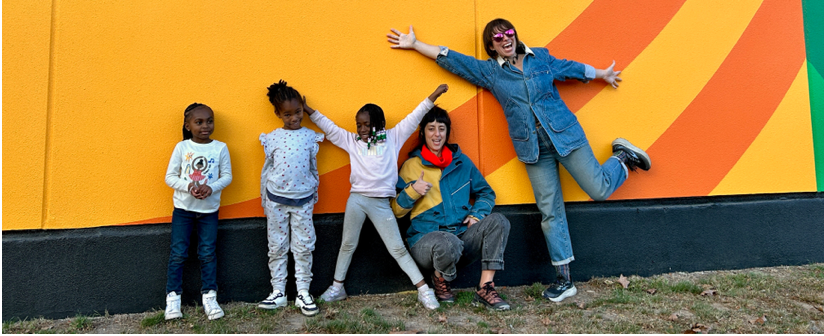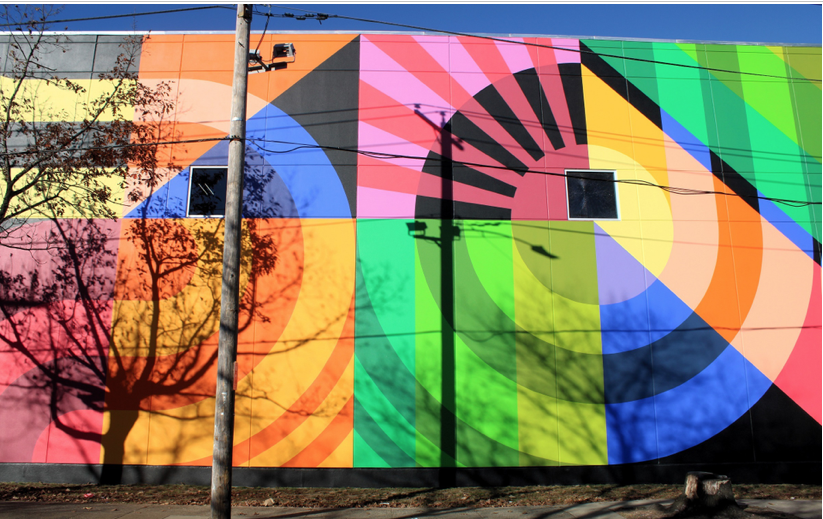The challenge was steep. To scour the globe for a muralist to lend such pizzazz to a 240-foot blank warehouse wall that it would bring life to a faded stretch of town.
In the end, one factor sealed the deal: cartwheels.
“We realized we never before had seen artists who cartwheeled in front of their finished work,” said Site Projects executive director Laura Clarke, referring to Jessie Unterhalter and Katey Truhn, the Baltimore-based artist team that recently completed the abstract, color-saturated, Sol LeWitt- and Josef Albers-inspired “Blue Moon Chapel” at the corner of Chapel and East Streets.
The Sunday afternoon event, the unveiling of the mural, buzzed with energy, with the gravel parking lot across the street serving as the site for an informal dance party, flea market, hula hoop contest, and roaming juggler. It concluded with a ribbon-cutting and a proclamation by emcee and official city historian Michael Morand that New Haven, with the possible exception of Philadelphia, was “the mural capital of the world.”
“The city came to us and asked us to do this,” said Clarke, of the 42,000 square-foot warehouse opened by Elm City Industrial Properties last year. “It was part of an agreement with the building owner that they would let him do the warehouses if he would include public art on the walls.”
The event coincided with the 20th anniversary of Site Projects, the nonprofit that commissions world class public art to New Haven, with projects ranging from neon sculpting by Leo Villareal on the Green, to a rainbow of laser beams blazing from the top of East Rock to mark New Haven’s 375th birthday, to an “anamorphic” optical illusion along the Chapel Street alleyway leading to Temple Plaza.
“We Americans build bigger and bigger houses and living rooms, but having a culture where people in a public space can share an experience and a connection, that goes a long way in bringing a community together,” said Clarke, before calling out for DJ Handsome to crank up the music and urging youngsters to the dance floor.
“In the 15 to 20 years this mural will last, a lot of the buildings around here will be turned into apartments,” said Clarke, as she gestured at a brick structure on Hamilton Street. “Just think what it will do to activate this neighborhood.”
Not only that, said Fair Haven community activist Lee Cruz, who had just joined her. Like all public art, he added, “it slows people down, it’s something to talk about, a point of reference.” Clarke nodded. “Plus people take ownership of it and feel pride in it.”
That goes to another reason Site Projects engaged Unterhalter and Truhn, Clarke said. Their mission, according to their website, is “to transform public spaces into vibrant, playful experiences to engage with the history, architecture, and culture of the places they paint.”
New Haveniana authority Robert Greenberg, executive director of the soon-to-be-opened Lost in New Haven museum, pronounced the project an unqualified success.
“This area was a hub of industry and innovation,” he said. Even before the H.B. Ives manufacturing plant, which for decades produced Home Depot-bound goods like house numbers and window locks, there was the Civil War-era Armstrong Carriage Co., with clients that included the crown princes of Europe; the Candee Rubber Co., pioneer of galoshes and gaiters; and Sargent and Co., a leading manufacturer of locks and hardware.
“These are the factories where so many immigrants dreaming of opportunity came to work and which contributed to the rich history of this city,” he said, registering his dismay at what he called the city’s inaction in preserving factory buildings in the area. “You can’t bring them back but you can celebrate them with something bright and vibrant.”
The mural, he said, “stitches the Wooster Square area to Fair Haven,” referring to the efforts toward reviving the former industrial neighborhood created on the eastern flank of Wooster Square by the construction of I‑91.
As opposed to a blank wall, he said, “this mural can be seen from I‑95, and it says to the millions of people a week who see it that we care about the arts and we care about how the neighborhood is transforming in important ways.”
After the ribbon cutting, three girls — Anaya, Payton, and Ellis – approached the two muralists. They all hugged.
As Rochelle McCain reported, her daughter Anaya passes the mural each day on their drive to Cold Spring School. “She talked with her friends about the different shapes, the colors, it’s really made an impression on her that anything can be a vessel for art and expression.”
“You don’t know how much your love of art and the mural has touched us,” Unterhalter told the girls. “This is why we’re doing this.”







